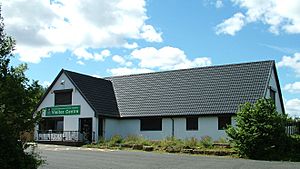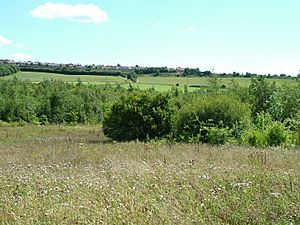Durham Wildlife Trust facts for kids

Rainton Meadows Visitor Centre, HQ of Durham Wildlife Trust
|
|
| Formation | 1971 |
|---|---|
| Type | Registered charity |
| Headquarters | Rainton Meadows, Houghton-le-Spring, Tyne and Wear, England |
The Durham Wildlife Trust is a charity that started in 1971. It was first called the Durham County Conservation Trust. In 1988, it became the Durham Wildlife Trust. This group works across the old area of County Durham. This includes places like Darlington, Gateshead, South Tyneside, and Sunderland.
The Durham Wildlife Trust is part of a bigger group called the Wildlife Trusts. This group has 46 charities all over the U.K. You can spot them by their badger logo. Each Wildlife Trust is its own group. They all work to protect nature in their local areas. These Trusts are also groups that people can join as members.
Durham Wildlife Trust looks after 50 nature reserves. These reserves are located between the Rivers Tees and Tyne. They include old woodlands, heathlands, meadows, and wetlands. These special places have helped save important natural areas in the North East of England.
Today, Durham Wildlife Trust keeps adding new reserves. They also run big projects to protect wildlife.
Contents
Protecting Wildlife: Projects
Durham Wildlife Trust leads many projects. They also work with other groups in the local area. The Trust is currently helping to protect animals like the great crested newt, the water vole, and the barn owl. They also played a big part in bringing otters back to the rivers in the county. Here are some of their recent and ongoing projects.
Heart of Durham
The Heart of Durham project is a team effort. Durham Wildlife Trust works with Northumbrian Water Limited on this project. It takes place around the edge of the North Pennines. This area stretches from the Derwent Reservoir in the north to Hamsterley Forest in the south. The project's main goal is to fix and create new natural areas. This helps wildlife to grow and thrive across a large landscape.
Nextdoor Nature
The Nextdoor Nature project is a big effort. It has £5 million from the UK National Lottery. Wildlife Trusts across the country are running it. This project will leave a lasting natural gift from Queen Elizabeth II's Platinum Jubilee. Nextdoor Nature wants to create a network of community-led projects. These projects help bring nature back to local areas. This is part of a total £22 million Lottery investment. It aims to celebrate the Jubilee and make life better for people in areas that need help.
Through Nextdoor Nature, Durham Wildlife Trust helps local groups and schools. They work in Sunderland, South Tyneside, East Durham, and Darlington. The Trust encourages them to work with their neighbors. This helps bring wildlife back and improve nature close to where people live.
Discover Brightwater
The Discover Brightwater Landscape Project gets help from the National Lottery Heritage Fund. This project aims to find, fix, and celebrate the history of the Brightwater area. This area is around the River Skerne. Durham Wildlife Trust is in charge of this big project. It involves 19 different smaller projects. These include making river habitats better and creating new wetlands. It also involves looking into history and archaeology with local communities. The project covers the River Skerne area. This goes from Trimdon Parish in the north to Darlington in the south and Shildon in the west. This project started in early 2018 and finished at the end of 2023.
Healing Nature
The Healing Nature Project ran from January 2021 to March 2022. This project received funding from the Green Recovery Challenge Fund. It was supported by the Department for Environment, Food & Rural Affairs (DEFRA). It also got help from Gateshead Council, South Tyneside Council, and Sunderland Council.
The project worked to improve habitats for wildlife. It also helped people and communities connect with their local green spaces. This happened at 20 sites across Gateshead, Sunderland, and South Tyneside. Over 845 people attended public events at these sites. More than 531 children from over 29 schools learned about nature through Healing Nature. Activities included managing 47.4 hectares of grassland. They also planted 650 meters of hedgerow and 1.15 hectares of native woodland. Plus, 14,000 wildflower bulbs were planted.
What the Trust Does
Durham Biodiversity Partnership
The Durham Biodiversity Partnership started in 1996. It covers the same area as Durham Wildlife Trust. This group helps plan and check how nature is protected in County Durham. Many different groups and people who care about nature are part of this Partnership.
Durham Wildlife Trust plays a key role in this Partnership. They provide a home for the Partnership at Rainton Meadows. The Trust is also part of the Partnership's main group. Other members include Natural England, the Environment Agency, and Northumbrian Water. The Trust also runs the Durham Biodiversity Data Service for the Partnership. This service collects important information about animals and plants.
Durham Wildlife Services Ltd
Durham Wildlife Services is a part of the Trust. It offers advice about nature to businesses and local councils. They help with things like checking natural areas. They also help measure how much nature is gained or lost in projects. The money made by Durham Wildlife Services helps support the work of Durham Wildlife Trust.
Education
Teaching people about nature is a very important part of the Trust's work. Their main education center is at Rainton Meadows. This center is near Houghton-le-Spring. It is close to many towns like Sunderland, Gateshead, and South Tyneside. It has an indoor classroom and a meeting center. There is also a second education center at Low Barns. This is near Bishop Auckland. This center is mostly for outdoor activities.
Besides their own centers, the Trust also visits schools and community groups. This is part of their education program.
Nature Reserves
The Trust manages many nature reserves. These include Bishop Middleham Quarry, Hawthorn Dene, and Low Barns. These places have important habitats. Some examples are grasslands on Magnesian Limestone, upland hay meadows, and coastal valleys. The magnesian limestone grasslands managed by the Trust are some of the best of their kind.
The Trust's biggest reserve is Hedleyhope Fell. It is near Tow Law and covers over 200 hectares. It is one of the best examples of recovering heathland in the county. This type of habitat is rare in County Durham. The site is very important because it has many rare plants and animals. These include lesser skullcap, stag's-horn clubmoss, and the velvet ant. The velvet ant has not been seen anywhere else in the county. Hedleyhope Fell is also home to many birds that breed there. It is also a key spot for the green hairstreak butterfly.
Reserve Locations
The Trust currently manages 50 reserves. Here are some of them:
| Reserve | Area (ha) | Grid reference | Owner |
| Addison and Hedgefield | 14.0 | NZ167641 | DWT |
| Baal Hill Wood | 15.5 | NZ069392 | DWT |
| Barlow Burn | 20.0 | NZ156618 | DWT |
| Bishop Middleham Quarry | 10.0 | NZ332326 | Leased from Church Commissioners |
| Black Plantation | 13.8 | NZ137449 | DWT |
| Blackhall Rocks | 32.4 | NZ470392 | Leased from Durham County Council |
| Burnhope Pond | 14.1 | NZ183480 | Leased from Durham County Council |
| Chopwell Meadows | 17.0 | NZ113584 | DWT (part of site was former Chopwell Colliery) |
| Edmondsley Wood | 12.5 | NZ229493 | DWT |
| Hannah's Meadows | 8.8 | NY934187 | DWT |
| Hawthorn Dene | 67.0 | NZ433458 | DWT / National Trust |
| Hedleyhope Fell | 202.0 | NZ139409 | DWT |
| Hesleden Dene | 8.5 | NZ444377 | DWT |
| High Wood NR | 2.5 | NZ128562 | DWT |
| Joe's Pond | 4.5 | NZ328487 | DWT |
| Longburnford Quarry | 1.0 | NZ072448 | DWT |
| Low Barns | 50 | NZ163313 | DWT |
| Malton NR | 4.5 | NZ182458 | Leased from Durham County Council |
| Milkwellburn Wood | 79.0 | NZ114570 | DWT |
| Rabbitbank Wood | 7.0 | NZ112483 | DWT |
| Ragpath Heath | 3.5 | NZ144448 | DWT |
| Rainton Meadows | 60.0 | NZ326485 | UK Coal Ltd / City of Sunderland |
| Raisby Hill Grassland | 11.5 | NZ335355 | DWT /Tarmac |
| Redcar Field | 0.4 | NZ292198 | DWT / Natural England |
| Shibdon Pond | 13.7 | NZ194628 | Metropolitan Borough of Gateshead Council |
| Stanley Moss NR | 7.5 | NZ150388 | DWT |
| Town Kelloe Bank | 5.0 | NZ357371 | DWT |
| Trimdon Grange Quarry | 5.0 | NZ361353 | Leased from Durham County Council |
| Tudhoe Mill Wood | 37.5 | NZ254357 | DWT / Whitwirth Estates |


